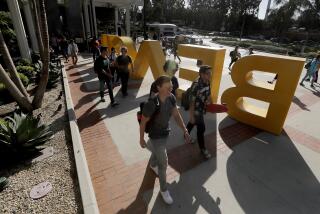Rancho Santiago Borrowing Plan Argued
- Share via
SANTA ANA — Administrators and faculty at Rancho Santiago College clashed at a Board of Trustees meeting Wednesday night over a proposal to borrow $31 million for technological improvements and new classrooms.
Rancho Santiago’s Chancellor Vivian Blevins urged the five-member Board of Trustees to approve the borrowing plan, which she maintained is desperately needed to overhaul the school’s aging computer system and to construct new buildings at its satellite Orange campus. The actions are vital to keep the school competitive, Blevins said.
Of Orange County’s eight community colleges this year, Rancho Santiago College posted the sharpest gains in enrollment, about 10%. The school now has about 24,000 students.
“We have tremendous needs,” Blevins said Wednesday. “We have to be able to offer our students an authentic education.”
But some faculty members contend the financing proposal would overwhelm the school with debt and mean possible cutbacks in student services, maintenance projects and faculty compensation. Some faculty fear that if the state, which supplies most of community college funding, runs into financial trouble, Rancho Santiago would suffer.
If state funding is curtailed, the school may be forced to service an annual debt of $2.5 million, thus creating a serious shortfall in the community college’s annual budget, the faculty members say.
“It only takes one bad year in Sacramento, and then we are in big, big trouble,” said Judy Chitlik, president of Rancho Santiago’s faculty association. “How could they encumber the college with a mortgage like this that could jeopardize faculty jobs?”
Philosophy instructor John Velasquez said the proposal to borrow money “is not clear to us and we do not have faith in it. . . . Something doesn’t feel right. We have been left out of the decision-making process.”
A furious trustee, Charles W. “Pete” Maddox, countered the criticism, saying: “I don’t want to attend another meeting like this. I do not want to continue wasting time. [The faculty’s] comments are irresponsible and misrepresent the facts.”
But some student representatives, staff members and faculty did urge the trustees to borrow the money as soon as possible.
“Equipment is obsolete,” said business instructor Maria Hernandez. “I need my students to be served now. I don’t think it’s so outrageous to borrow money . . . . Let’s get the ball moving. Let’s get the equipment in the classroom.”
Trustees said they have involved the faculty in prior discussions about borrowing the money, but conceded that without the faculty backing the move, it would surely fail. They challenged the faculty to come up with a plan for funding for the new buildings and technology.
Dan Goldman, a science instructor and president of the Academic Senate, said his group will write a plan, identifying the district’s needs and how to fund them and present it to the board in six weeks.
“No program gets implemented in the way it should unless faculty and staff are on board,” trustee Michael Ortell said.
Trustees expect to make a decision in six weeks.
Administrators want to obtain a type of bond called a certificate of participation for $31 million to finance the upgrades.
More to Read
Sign up for Essential California
The most important California stories and recommendations in your inbox every morning.
You may occasionally receive promotional content from the Los Angeles Times.










